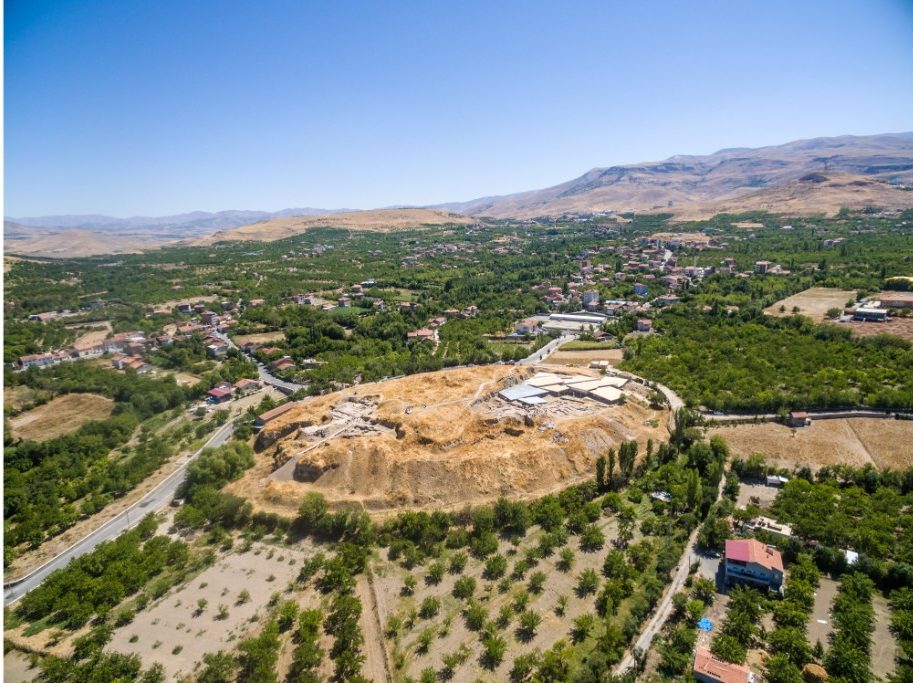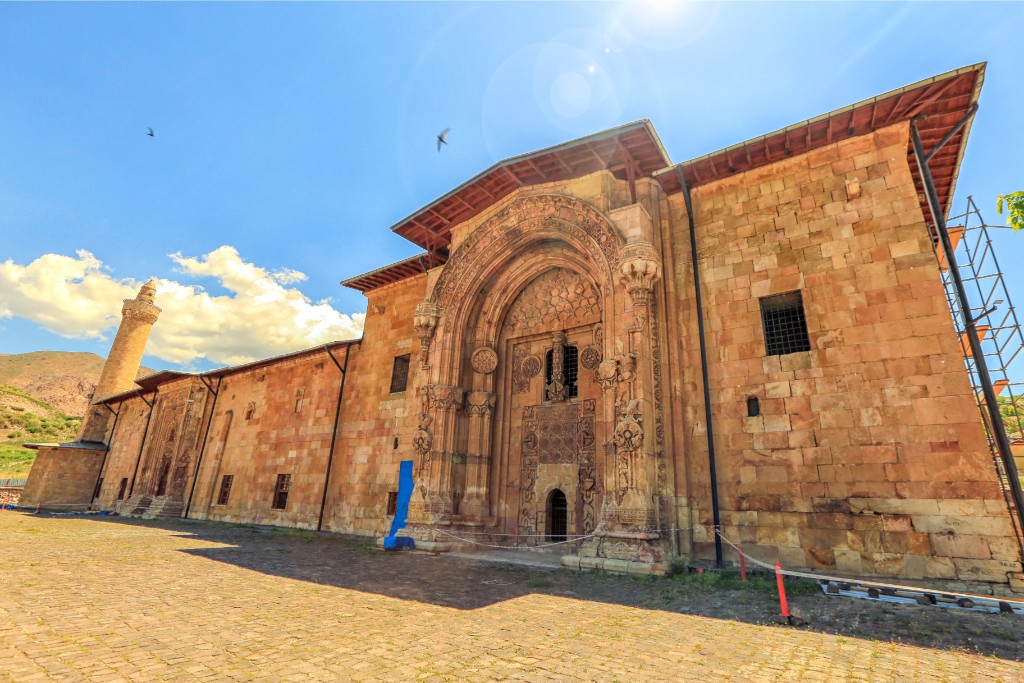UNESCO sites in Turkey
If you are into ancient civilizations, Turkey is the perfect destination for your vacation. Namely, there are 19 UNESCO sites in Turkey, and 13 of them include ancient settlements. From former capitals of culture brimming with temples, tombs, impressive theatres, and nymphaeums to mythical and mysterious places whose secrets are unknown to this day, there is a lot to discover about this fascinating country. Furthermore, its incredibly rich history contains traces from thousands of years ago and includes a lot of the “world’s firsts” such as the first temple and the first hospital.
At the end of the post, you will find a map of all UNESCO sites in Turkey for easier navigation.
Table of Contents
Aphrodisias
Aphrodisias is an ancient city that was once the capital of the Roman province of Caria. Today, this ancient Greek Hellenistic settlement remains include a monumental gateway, Temple of Aphrodite, Bouleuterion, Sebasteion, and the stadium. Moreover, the latest excavations have been very successful. In 2018 an ancient tomb was found in the area, and in 2020 two sarcophagi were discovered. Obviously, the area is brimming with historical findings. Who knows, you might even find something yourself when visiting.
Archaeological Site of Ani
The Archaeological Site of Ani, also known as the Ancient Ghost City of Ani, is a medieval Armenian city, or more precisely, its ruins. Furthermore, this iconic site is a mix of residential, religious, and military structures, parts of which are very well preserved. Moreover, the remains are truly jaw-dropping as while exploring this ghost town you can’t help but wonder what the lives of its former inhabitants were like.
Archaeological Site of Troy
One of the most popular UNESCO sites in Turkey, Troy contains around 4,000 years of history and is possibly the most famous archaeological site in the world. Moreover, the first excavations on this site started in 1870, and with further excavation, more and more layers of earlier settlements were discovered. Currently, there are 10 layers starting with Troy 0 which dates back to approximately 3600-3500 BC and ends around 3000 BC. The last layer is Troy IX which dates back to around 85 BC and ends around 500 AD. Interestingly, several layers actually resemble the literary depictions of Troy which leads to believe that there’s some truth in the legends. However, it is still not clear where the border between reality and myth is.
Arslantepe Mound
Arslantepe Mound is another ancient city and the newest addition to UNESCO sites in Turkey so far. It was named a UNESCO World Heritage Site in 2021 but it dates back to the Chalcolithic period (Copper Age). Furthermore, the area is known for the excavation of the earliest swords in the world so far which indicates the beginning of a form of organized battle. In addition, numerous mural paintings and stone carvings have been found in the area.
Bursa and Cumalıkızık: the Birth of the Ottoman Empire
Bursa was created in the 14th century by the Ottomans. It served as their first capital and the Sultan’s seat. Namely, Bursa was the first city in the Ottoman Empire and, therefore, it represents the development of urban growth of the empire. Furthermore, Cumalıkızık is a nearby village that represents the support for the capital’s hinterland. Hence, in addition to being prime examples of an urban and rural system created by the first Ottoman sultans, Bursa and Cumalıkızık are also a place where this mighty empire was born.
City of Safranbolu
In 1994 Safranbolu was added to the list of UNESCO sites in Turkey. Namely, the city was an important caravan station from the 13th until the 20th century. Furthermore, it is an authentic Ottoman city with numerous historic buildings and streets. What’s more, 1008 buildings in the city are registered as historical artifacts. They include mosques, tombs, historical fountains, Turkish baths, and caravanserais. Moreover, while strolling through the city’s narrow stone-paved streets and admiring its unique architecture, you will feel like going back in time.
Diyarbakır Fortress and Hevsel Gardens Cultural Landscape
Diyarbakır Fortress consists of İçkale (Inner Castle) and Diyarbakır City Walls (Outer Castle). Furthermore, the city walls are 5.8 kilometers long and they include numerous towers, gates, buttresses, and inscriptions. What’s more, they originate from the ancient city of Amida which once stood on the ground of Mesopotamia. In addition, Hevsel Gardens are located just outside the walls, near the Tigris river. Namely, in the past, these gardens were created to provide food and water for the citizens. Interestingly, even today a third of the area is used for cultivating food.
Ephesus
Ephesus was built in the 10th century BC and it is a prime example of an Ancient Greek settlement. It is best known for its numerous monumental buildings such as the Library of Celsus and the Temple of Artemis which is proclaimed one of the Seven Wonders of the Ancient World. Another famous attraction is the Great Theater, and it is indeed great as it can accommodate up to 24,000 spectators. How impressive is that? In addition, if you visit the Ephesus Archaeological Museum, you can see a remarkable collection of Ephesus excavation site finds including the statue of the Greek Goddess Artemis.
Göbekli Tepe
Göbekli Tepe is an archaeological site around 12,000 years old. It is described as the world’s first temple but a lot about it is a mystery. Interestingly, this mystery older than Stonehenge also consists of circular stone pillars. The most famous one is Pillar 43, also known as the Vulture Stone. Due to the characters it depicts, some believe it has something to do with the Barasana hunter-gatherer secret society’s zodiac. However, others think it shows the date and time of a comet impact in 10,950 BC. In addition, some suspect that the site was built by aliens because some of its statues depict alien-like figures. Whatever it is, one thing is for sure- it is fascinating.
Göreme National Park and the Rock Sites of Cappadocia
In 1985 Göreme National Park and the Rock Sites of Cappadocia were added to the list of UNESCO sites in Turkey. The site is located in Central Anatolia in a magnificent volcanic landscape sculpted by erosion. Furthermore, the site comprises mountain ridges, plateaus, valleys, and pinnacles known as “fairy chimneys”. However, it is not entirely created by nature itself. A fascinating network of ancient, interconnected underground settlements was created by men to protect the villages from Arab marauders. Amazingly, some people still live there.
Great Mosque and Hospital of Divriği
This masterpiece of Islamic architecture is best known for its contrasting exterior and interior. Namely, the exterior is brimming with lavishing decorative sculpture, and the interior has unadorned walls, massive stone piers, and vaults. Furthermore, one of its most impressive features is the densely ornamented mosque portal on the northern side of the building. It consists of high-relief stone carvings of the Tree of Life that signifies paradise and rosettes that signify eternity. That’s why it is also known as the Paradise Portal.
Hattusha: the Hittite Capital
Hattusha is an open-air museum that includes temples, monumental gates, royal buildings, and city walls. It is divided into two parts: Upper City and Lower City. Furthermore, the Upper City is known as the Temple District. Namely, it consists of temples and sanctuaries and its southern part is surrounded by a wall with four gates. On the other hand, the Lower City is where the civilian housing was. However, in the middle of it is the Great Temple, the biggest sacred structure of Hattusha. It is dedicated to Teshup, the Storm God, and Arinna, the Sun Goddess.
Hierapolis-Pamukkale
Hierapolis-Pamukkale is a site that comprises an ancient spa as well as imposing ruins from the Greco-Roman and Byzantine periods. Hierapolis means “holy city” and includes temples, baths, a necropolis, a monumental arch, a nymphaeum, as well as a grand theatre that is still in use today. Furthermore, Pamukkale is a natural phenomenon, also known as the Cotton Palace. It consists of magnificent large basins filled with thermal water that do look like they’re made of cotton. This remarkable combination of natural formations and city ruins is something not to be missed when visiting Turkey.
Historic Areas of Istanbul
Due to its rich history and beautiful monuments, Istanbul is one of the top places to visit in Turkey. Historic Areas of Istanbul include a group of sites spread across four areas that represent the city’s history. Furthermore, these areas comprise the Archaeological Park, the Suleymaniye Quarter, the Zeyrek area, and the area along both sides of the Theodosian Walls. Moreover, Istanbul’s unique and stunning skyline owes its beauty to numerous historical sites situated in these four areas. The most important buildings and structures include the Blue Mosque, the Şehzade Mosque complex, the Topkapi Palace, the hippodrome of Constantine, and the aqueduct of Valens.
Nemrut Dağ
Nemrut Dağ is a temple-tomb and a house of gods, built by King Antiochus I Theos of Commagene as a monument to himself. Furthermore, he wanted his tomb to be built in a high and holy place, close to gods and away from people. Therefore, the highest peaks of the Eastern Taurus Mountains served as a perfect location. In addition, the site includes colossal statues of himself, two lions, two eagles, and several gods. Interestingly, although it is believed that this is Antiochus’ place of burial, his tomb hasn’t been found to this day.
Neolithic Site of Çatalhöyük
Çatalhöyük is a site that includes a rare and extremely well-preserved example of a Neolithic settlement. What’s more, it consists almost entirely of domestic buildings, or to be more specific, back-to-back houses with roof access. However, there are no evident public buildings. Therefore, it is one of the most important sites for understanding the early settled agricultural life of humans. Besides that, it also includes numerous wall paintings and reliefs depicting the symbolic world of its inhabitants.
Pergamon and its Multi-Layered Cultural Landscape
Pergamon, also known as Pergamum, is another site where you can discover how ancient civilizations lived. However, it is a lot more than just a city. Its multilayered cultural landscape includes Hellenistic, Roman, Byzantine, and Ottoman structures. Furthermore, it was a cultural center with an amphitheatre that could accommodate around 50,000 people and a theatre for approximately 30,000 people. What’s more, it was home to the first hospital called Asklepion, built in honour of the god of healing. In addition, Pergamon’s remains are very well-preserved and the surrounding landscape is absolutely breathtaking.
Selimiye Mosque and its Social Complex
The magnificent Selimiye Mosque and its Social Complex is a masterpiece of Turkish art and architecture, visible from all over the city of Edirne. However, its size that dominates the city’s skyline is not the only thing that’s impressive. Unlike other mosques, the way its interior is organized makes it possible to see the mihrab from any location inside the mosque. Besides the unique architecture, the mosque’s stunning decorations evoke admiration with the refined details found in marble, tiles, and mother-of-pearl inlays.
Xanthos-Letoon
Xanthos and Letoon are twin cities that represent the Lycian civilization. Whilst Xanthos was the center of culture and commerce, Letoon was a religious and political center. Although they are two separate sites, they have joint importance and thus are inscribed together on UNESCO’s list. What’s more, they are only 5 kilometers apart so it is easy to walk from one site to another. Furthermore, the remains are well preserved and include two amphitheatres, a nymphaeum, a temple, Roman baths, and numerous tombs. In addition, strolling around these sites is a unique experience as it will give you an insight into how people lived thousands of years ago.
























